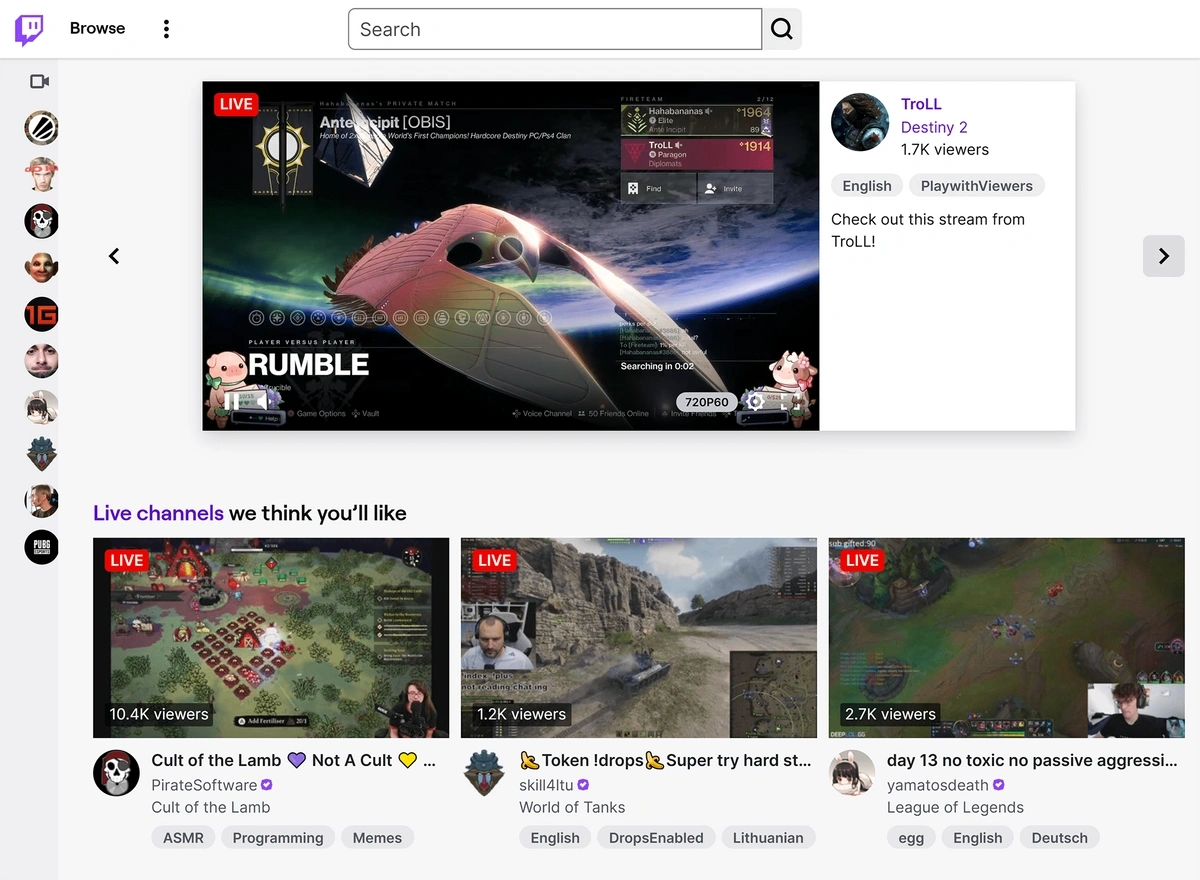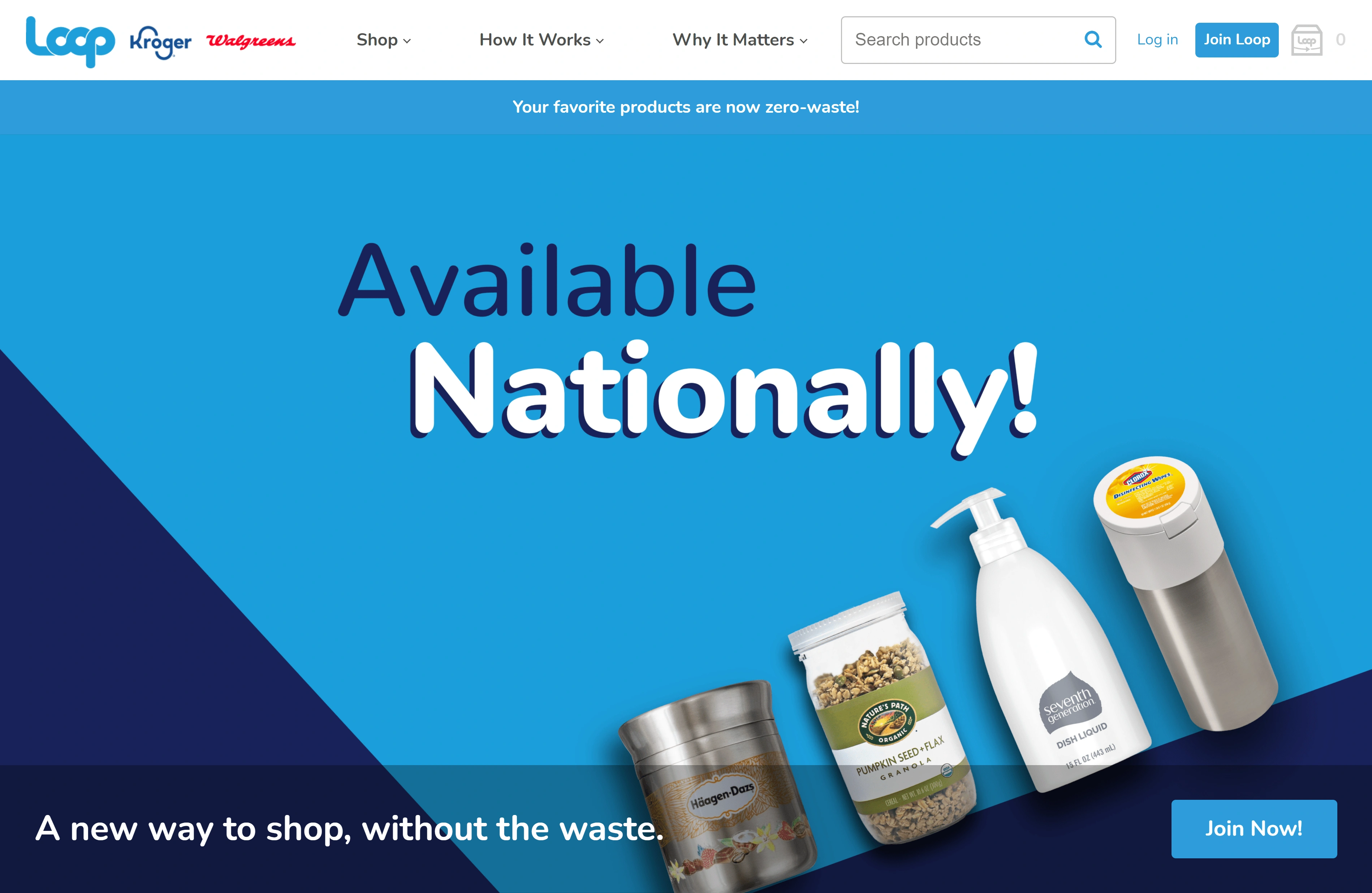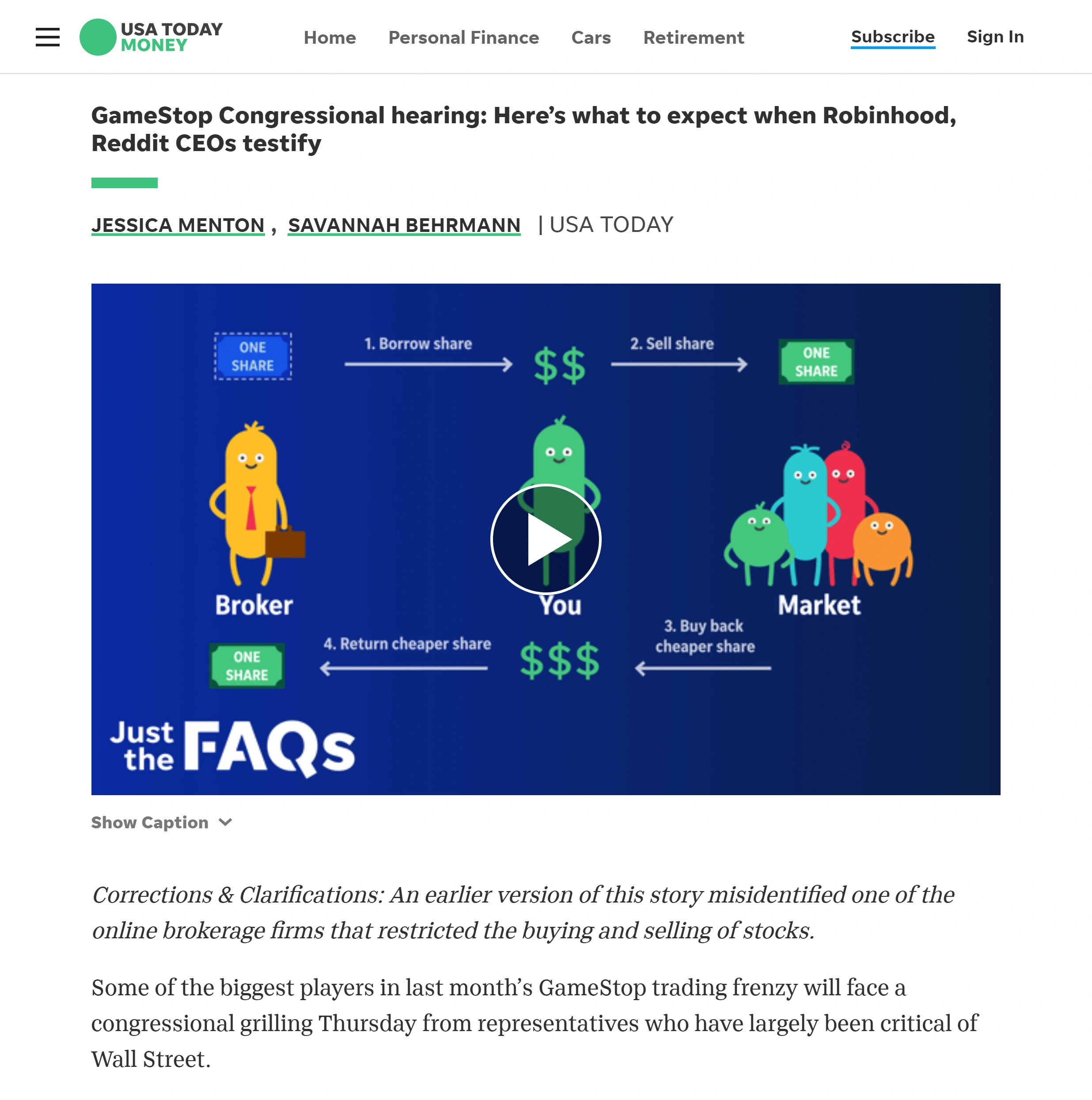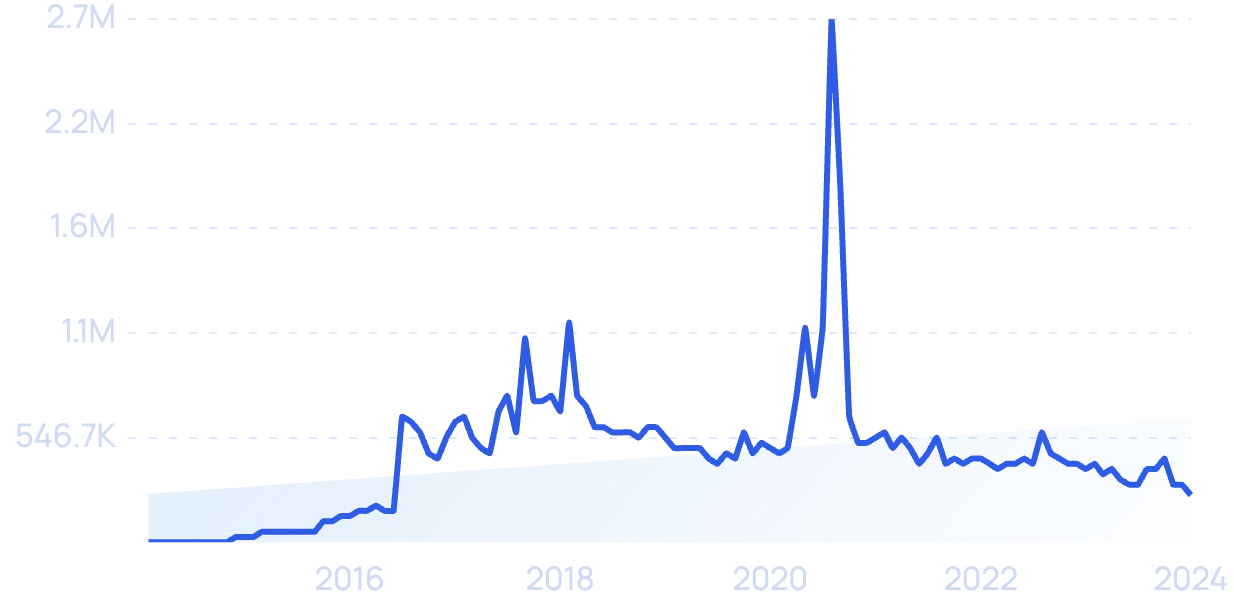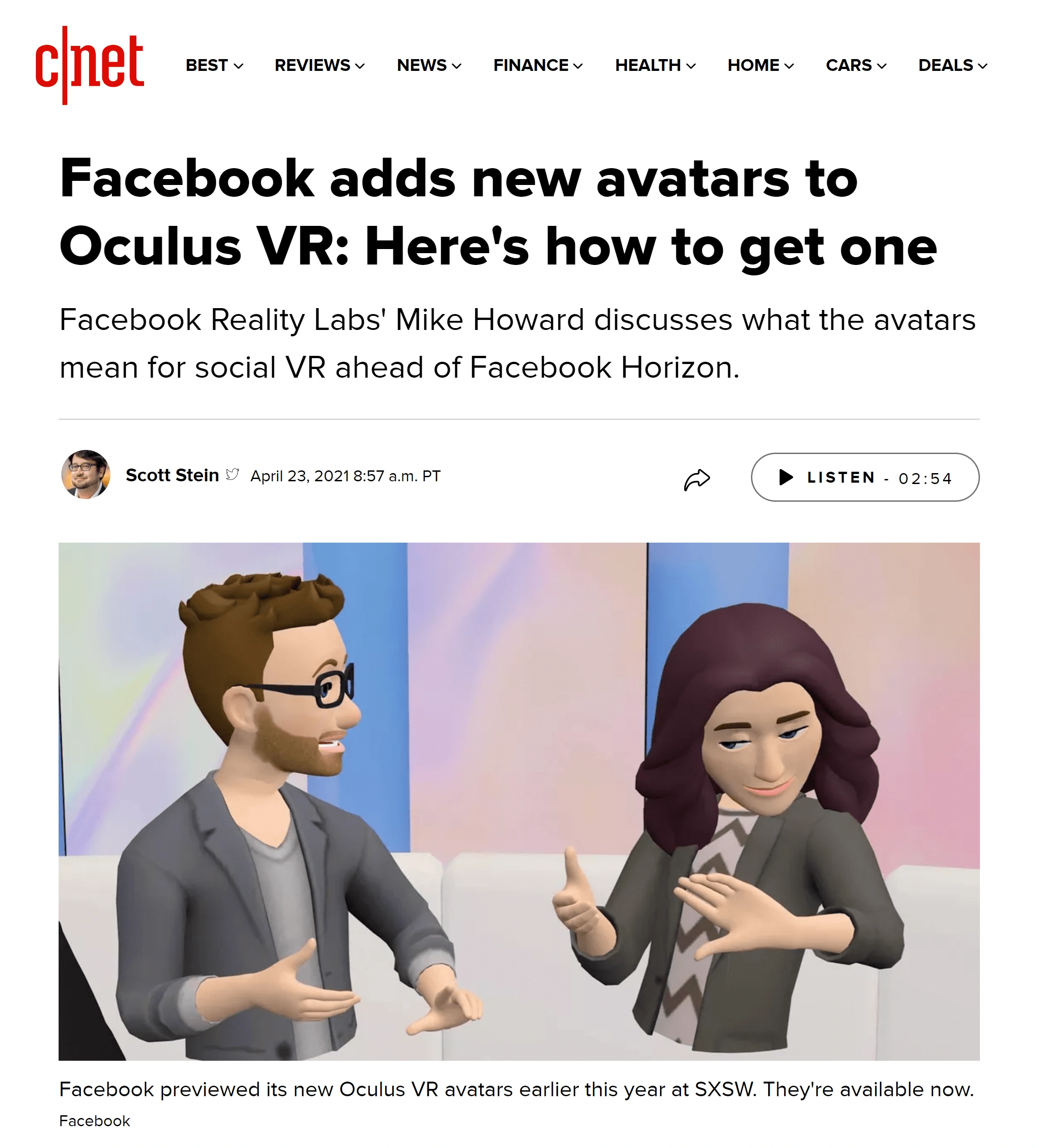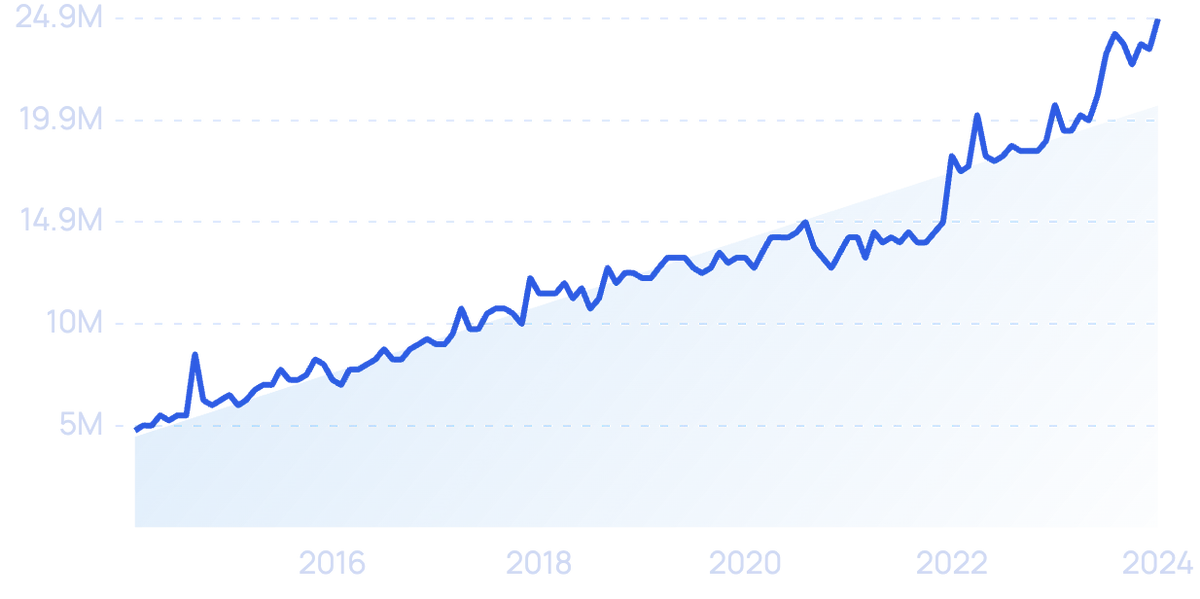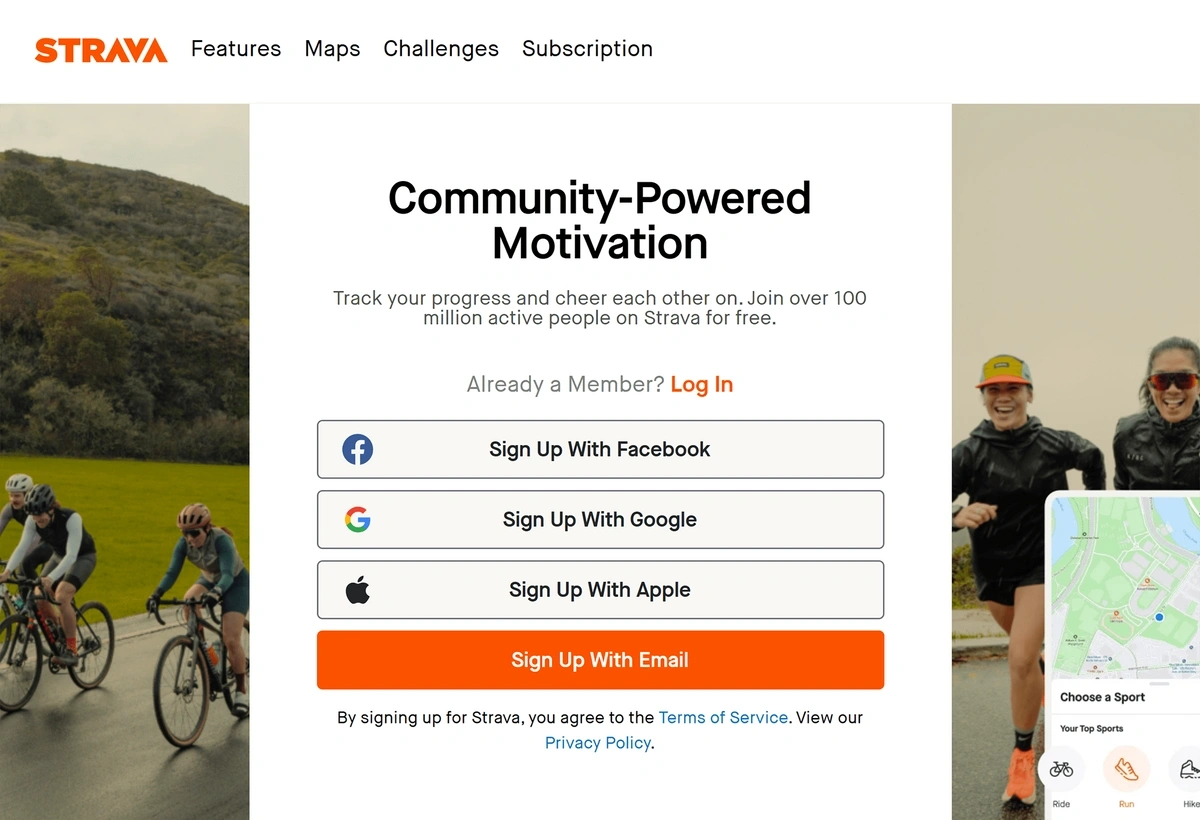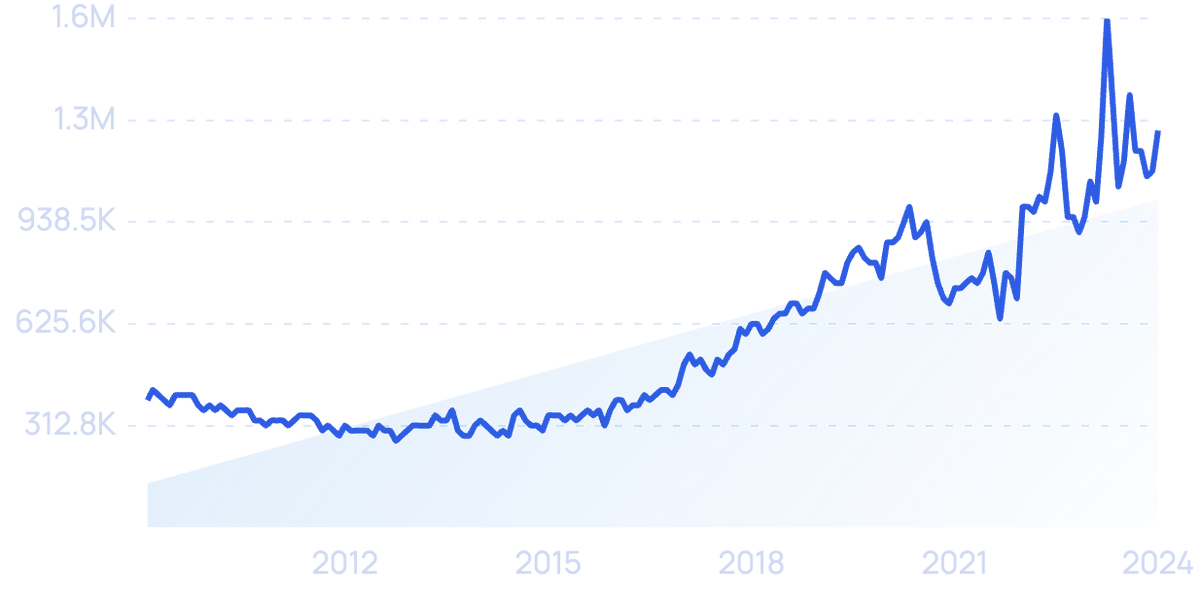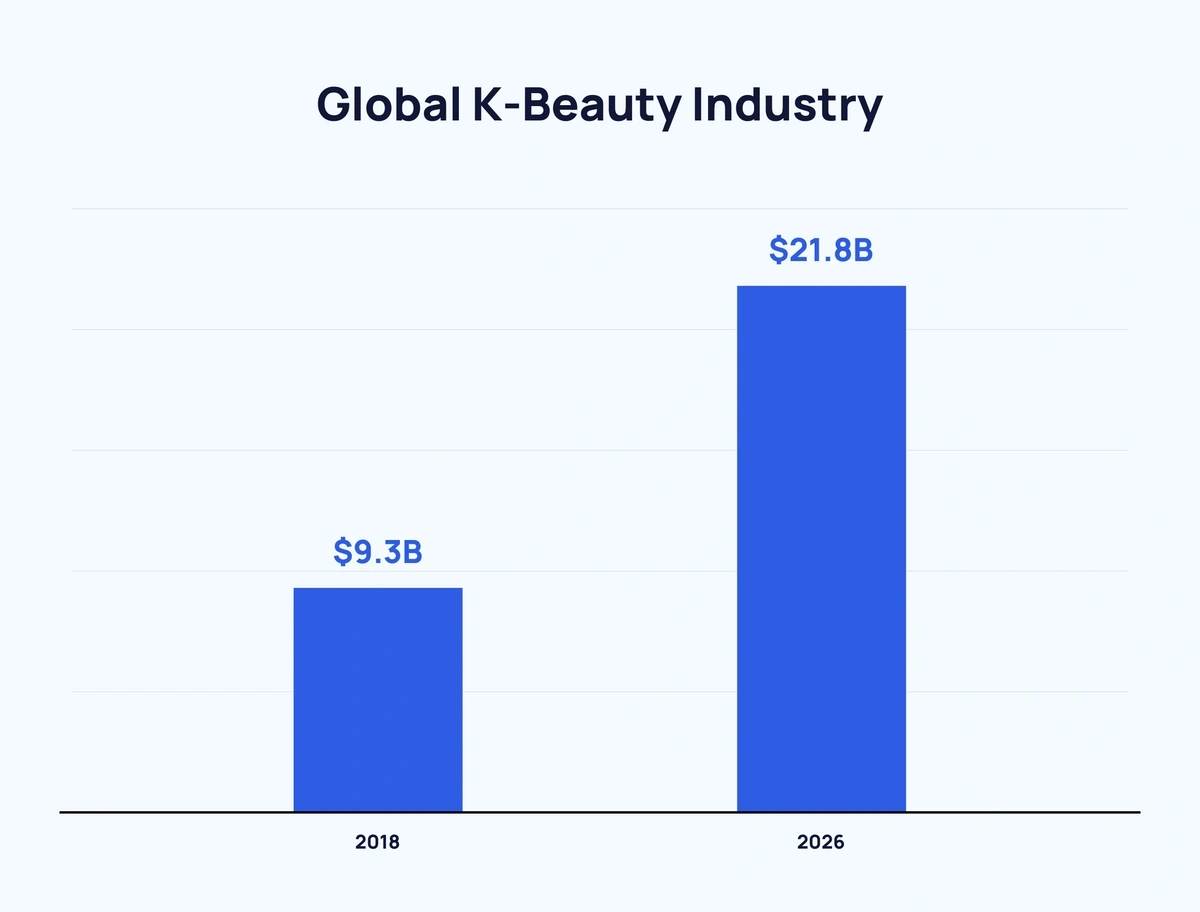
7 Top Cultural Trends (2024 & 2025)
You may also like:
From pop culture to niche interests, culture never stands still.
Plus, culture tends to affect everything from consumer behavior to technological innovation.
If you want to learn about the most important cultural trends for 2024 and beyond, read on.
1. The Creator Economy Keeps Growing
One of the fastest-growing cultural trends is the rise of the creator economy.
Searches for “creator economy” have grown by 6,400% over 5 years.
Thanks largely to platforms like TikTok and YouTube, people are spending more time consuming content created by individuals.
And viewers are increasingly flocking to platforms like Twitch to watch “amateur” content instead of professionally produced television.
Consumers are increasingly gravitating towards content created by individuals on platforms like Twitch.
In fact, Twitch’s peak concurrent viewership was already surpassing major cable networks like CNN back in 2018.
According to the latest available data (May 2024), Twitch racks up over 1.6 billion hours of monthly watch time.
More important than consumption, however, is the number of new creators that are emerging in this environment.
It’s estimated that 50 million people around the world now consider themselves "creators".
A growing number of people are making a living as "creators".
One survey even shows that more kids today want to become YouTube stars than astronauts.
The professional YouTube dream, though, may be out of reach for most.
97.5% of YouTubers make less than $12,000 from the platform.
On the other hand, the number of YouTube channels that made five or six figures has grown by 40%.
So while unlikely, there is potential to turn YouTube into a full-time gig. Or a small business.
To get a real feel for the size of the creator economy, just look at the influencer space.
A market that didn’t exist 20 years ago is now worth roughly $16 billion.
This has even spawned a new kind of creator – the micro-influencer.
Searches for "Micro Influencers" has grown steadily over the last 5 years.
These are individuals with smaller followings, but they make up the majority of the influencers on popular platforms like Instagram.
In fact, more than approximately 46% of Instagram accounts have more than 1,000 followers.
And it’s estimated that 15-100K follower-accounts makes up 81% of influencers on the platform.
Over half of these influencers also say they want to work as full-time creators.
This sector of the market is also very effective as a marketing funnel.
Data has shown that influencer accounts with a relatively lower number of followers actually drive more engagement.
Influencers with audiences of up to 15,000 followers typically see engagement rates of 3.86%.
This figure decreases as followers rise.
And by contrast, accounts with an audience of 1,000,000 have an average engagement rate of only 1.21%.
In the newsletter space, companies like Substack are enabling writers to support themselves from their content.
Searches for "Substack" have increased by 9,800% over the last 5 years.
The company has raised $90 million in VC funding to date.
And some of the platform’s top content creators are making several hundred thousand a year through their paid newsletters.
2. Brand Purpose and Activism Gain Importance
It’s no secret that a growing number of corporations and global brands are engaging in social activism.
And for good reason.
A Deloitte survey found that 19% of customers strongly agreed that purpose driven brand actions positively affected their purchasing behavior.
A growing number of consumers put brand activism above traditional factors, like price and convenience.
On the flip side, 26% said that negative brand behavior also negatively affected their decision to buy.
One of the most prominent brand social stances has involved climate change.
According to Nielson, 81% of consumers feel that companies should take action to improve the environment.
Approaching brand purpose as a viable investment has also helped some companies grow.
After creating its Sustainable Living Brands, Unilever saw those brands grow 69% faster than the rest of its business the following year.
There are even entire brands created with activism in mind.
The TerraCycle brand Loop is a good example.
Loop’s entire purpose is focused around a sustainability angle.
Loop's brand ethos is all about reducing environmental impact.
The company creates reusable packaging for products like lotion and wipes.
Loop displays this fact prominently on its website. And on social media.
3. Nostalgia Drives Entertainment
Nostalgia is playing an increasingly important role in entertainment.
Before it left Netflix for NBCUniversal’s Peacock streaming service, Friends was one of the most watched shows on Netflix.
Usually following close behind was the 80s-themed Netflix original, Stranger Things.
Stranger Things appeals to adults looking for a modern-day take on 80s movies.
Netflix has also rebooted older franchises like Full House, Wet Hot American Summer, and Gilmore Girls.
In addition, Cobra Kai, a show based on the 80s Karate Kid movie franchise, is one of the most popular shows on Netflix.
On top of that, some of the highest grossing films of the last decade were remakes or re-imaginings of older franchises, such as Star Wars: The Force Awakens, The Lion King (live-action version), and Jurassic World.
A few years back Bob Dylan sold his 600-song music catalog to Universal Music Group for an estimated $300 million.
Three members of Fleetwood Mac sold their catalogs as well after a popular TikTok video caused a resurgence in interest.
4. The Digital World is Bleeding into the Physical World
Everything in the physical world is now influenced by what happens online.
Just look at the GameStop Congressional Hearing.
Congress's hearing on the Robinhood/GameStop trading controversy is a great example of a digital trend impacting "the real world".
The entire ordeal was influenced by the online community site Reddit. Which morphed from a fringe topic on an online forum to being the center of Congressional attention.
This isn’t just relegated to news coverage, however. GIFs, once the language of the internet, have now become a part of everyday life.
Searches for "GIF" have risen 71% over the past 10 years.
Facebook even acquired the online GIF library, Giphy, for $400 million.
In addition, virtual representations of people are becoming more common online.
Snapchat reported that 70% of its daily active users (147 million people) used Bitmojis to represent themselves on the platform.
Searches for "Bitmoji" have grown 800% over the past 10 years.
Competitors have caught on to the phenomenon as well, with Apple, Samsung, and Google all releasing emoji-based characters.
Facebook even introduced its own Facebook Avatars to the US after initially rolling them out abroad.
Facebook Avatars can be used on the traditional Facebook social network. And via Oculus VR.
This digitally-native method of communication has become ingrained in our culture.
It’s estimated that over 5 billion emojis are sent through Facebook Messenger alone every day.
Social gatherings are increasingly becoming digital as well.
After attracting 10 million viewers to a Marshmello concert in 2019, Fortnite hosted an event featuring Travis Scott in April of 2020 that drew over 12 million concurrent viewers.
And after the success of these two concerts, Epic Games (the creator of Fortnite) started a Fortnite concert series featuring artists like Steve Aoki, Deadmau5, and Anderson Paak.
And their Big Bang Event drew in an estimated 3 million concurrent viewers.
5. Communities Move Online
Humans have a need for community.
And that need is, more than ever, being fulfilled by online communities.
Instead of being restricted by geography, people are now finding groups of peers with similar interests and hobbies.
For instance, Facebook reports that 1.8 billion people use Facebook Groups every month.
In addition, one of the largest hubs for niche online communities, Reddit, has seen impressive user and engagement growth over the past 24 months.
Search interest in "Reddit" has increased by 426% over the last decade.
The number of active Reddit users is now up 500 million (which is a 150 million user increase since 2019).
The chat app Discord has also shown that interest in audio-based communities is increasing. Its monthly active users has now reached 200 million monthly users.
Searchers for "Discord" have grown by 196% over 5 years.
We’re seeing entire communities form in super niche areas.
Letterboxd, a social media site for films and TV, has seen consumer interest explode over the last few years.
Search interest in "Letterboxd" has grown 518% over the last 5 years.
The same trend is happening in the video game and fitness communities.
For example, games like Fortnite and PUBG make money by offering community-based add-ons (the games themselves are free to play).
The platforms make money from microtransactions.
Specifically, users buy things like accessories and costumes that enhance their status in the in-game community.
Microtransactions make up a growing element of the video game industry's annual revenue.
These purchases don’t affect gameplay. Instead, they change how the users interact with each other.
And it’s not like this is a fledgling concept.
It’s estimated that over 80% of revenue for the entire gaming industry over a two year span came from the free-to-play business model.
The fitness industry is also shifting to community-based applications.
Strava and Runkeeper are two examples of fitness companies focused on community.
Strava is a popular fitness community app focused on cyclists.
The two apps allow users to track their workouts and share fitness goals and accomplishments with others.
6. Tabletop Games Make a Comeback
People are increasingly seeking out analog entertainment options.
The rise of tabletop games is one of the best examples of this cultural trend.
For example, a Kickstarter campaign was launched for a board game called Frosthaven. It had a funding goal of $500,000.
It raised $3 million instead — in the first 3 hours.
By the time the campaign ended, the board game had raised nearly $13 million.
Frosthaven's Kickstarter campaign shows that there's growing interest in tabletop gaming.
Making it the third most-funded product ever released on Kickstarter.
The global market for playing cards and board games is expected to reach $21.56 billion by 2025, giving it a CAGR of 8.7%.
The tabletop gaming space is on the rise.
Interest in tabletop games has been growing for some time now: Reddit’s r/boardgames sits just outside the top 100 subreddits by subscribers.
And post-pandemic, “board game cafes” are quickly regaining popularity:
Search growth for “board game cafe” is on the rise once more.
But tabletop games offer something digital entertainment doesn’t: a break from "screen fatigue".
Searches for “screen fatigue” have been rising.
Classic board games like Monopoly, chess, and Scrabble are perennial best-sellers of the industry.
But over the past few decades, comparatively newer games like Asmodee’s Catan and Cards Against Humanity have started to take market share.
Catan was released in 1995 and has sold tens of millions of copies to date.
While Cards Against Humanity made an estimated $12 million in its first two years alone, after launching via a $16,000 Kickstarter campaign in 2011.
Geekier, hobbyist-type games have also become a larger part of the niche industry.
Hasbro is a market leader in both types of games.
The company owns casual board game brands Parker Brothers (Monopoly, Sorry, Trivial Pursuit) and Milton Bradley (Scrabble, The Game of Life, Parcheesi).
But it also owns Wizards of the Coast, which makes in-depth hobbyist tabletop games like Dungeons & Dragons and Magic: the Gathering.
Those games have huge followings in their own right.
According to a 2024 report, Dungeons & Dragons remains extremely popular.
With double-digit sales growth in each of the previous 5 years.
And based on its search interest, that trend seems to be continuing:
Searches for "Dungeons & Dragons" reached a 15-year high in 2023.
This newfound popularity has sprouted DnD-themed shows like Critical Role on Twitch and Relics and Rarities on YouTube.
There are now over a dozen Twitch channels devoted to Dungeons & Dragons. Plus many more recurring streams on other channels.
DnD has also inspired recent video games like Popup Dungeon (which was another Kickstarter-funded project).
Wizards of the Coast’s other star, Magic: the Gathering, is also booming.
(The card game’s sales are up significantly YoY.)
Several platforms have also arisen to let people play Magic online.
First is Wizards of the Coast’s own Magic: the Gathering Arena. Which is a fully digital version of the game.
But players can also use their physical cards to play online via Zoom, Skype, or a dedicated service like SpellTable (which was acquired by Wizards of the Coast earlier this year).
Magic: the Gathering is being played online via webcam using SpellTable.
Magic: the Gathering has sprouted an entire ecosystem of businesses to support its players. (And for players of similar collectible card games.)
Naturally, there are numerous brick-and-mortar and ecommerce retailers.
But there are also:
Independent marketplaces like CardTrader and Cardmarket.
Monthly subscription boxes including Fantasy Crate and Mystery Magic Crates.
Card rental services like ManaTrader and Cardhoarder.
Deck designing software and sites like Moxfield, MTG Studio, and ManaStack.
Done-for-you deck-building services on Fiverr.
Paid coaching services and courses from Spikes Academy and Gamer Sensei.
Myriad physical accessories brands including Ultimate Guard and Dragon Shield.
As well as resources like MTGStocks and Quiet Speculation that focus on the cards’ investment value. (One rare Magic card sold to Post Malone for $2 million in 2023.)
7. The "Korean Wave" Continues to Make Inroads
The K-beauty industry (beauty products originally from South Korea) was worth $9.3 billion in 2018 and is expected to grow to $21.8 billion by 2026.
Estimated growth of the K-beauty space.
But K-beauty is just the tip of the iceberg.
All sorts of Korean products and habits are being adopted globally in a meta trend called the Korean Wave (or “Hallyu”). Which South Korea sees as a major driving force in their economy going forward.
For example, K-pop music is taking the world by storm.
BTS and BLACKPINK are the biggest names in K-pop, together claiming the majority of 100 million global fans.
BTS is an extremely popular K-pop group.
On YouTube, the two groups each of the top 9 records for the number of views in the first 24 hours of a music video.
Korean TV and film is also making a splash.
K-dramas are one major part.
For example, Netflix's "The Glory", racked up over 600 million hours of viewing time within hours of its release.
And with the Oscar's nod to Parasite — the only foreign-language film to ever win Best Picture — Korean cinema may be having a watershed moment.
But virtual influencers may be the next Korean trend to take the West by storm.
Search growth for "virtual influencer" has increased by 569% in 5 years.
It isn’t clear if this trend actually originated in South Korea.
But Korean businesses like Seoul-based Afun Interactive are playing a major role in pushing it forward.
The company creates virtual pop stars, actors, and models, the most popular of which have amassed millions of social followers.
Beyond following digital celebrities, people are creating their own avatars. Apple’s Memoji and Snapchat’s Bitmoji are basic face-only examples you’ve probably seen.
But the Korean app Zepeto takes it to the next level with full-body avatars and accessories that can interact in a virtual world.
It has even partnered with Western brands like Disney and Nike to create and sell branded virtual items.
The video game industry is also influenced by Korean trends.
South Korea has led the global eSports market for decades.
The global eSports market is estimated to be worth approximately $1.6 billion. And that’s without including sales of hardware like computer mice and keyboards.
In South Korea, eSports-watching is mainstream. There, each eSports event draws an estimated 10 million viewers.
The country even has 3 TV channels devoted exclusively to eSports.
This fanaticism has made Seoul a common place for major game developers to open satellite studios or subsidiaries. Electronic Arts, Activision Blizzard, Epic Games, and Ubisoft have all done so.
Conclusion
That’s all for the top culture trends for 2024 and 2025.
It’s obvious that digital innovation has driven a lot of cultural change over the past few years.
So, more than anything else, expect new technology to drive cultural change in the future as well.


